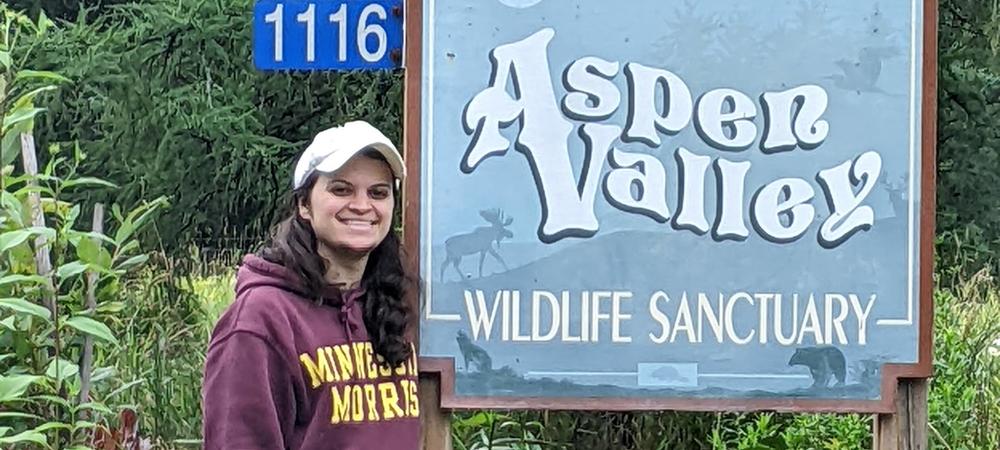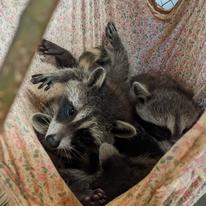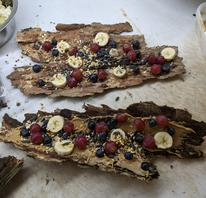
Whatever you might think an environmental studies major prepares you for, Mars Rigenhagen-Risch ’22, wants you to know that it can also include making hammocks for baby raccoons and charcuterie boards for baby bears.
Rigenhagen-Risch spent six weeks in July and August of 2022 working at the Aspen Valley Wildlife Sanctuary in Rosseau, Ontario. Aspen Valley is a nonprofit wildlife rehabilitation center that cares for injured and orphaned wildlife.
Rigenhagen-Risch knew he wanted to learn more about wildlife sanctuaries, so he also looked into internships in Colorado and British Columbia before choosing to intern at Aspen Valley.
“Most of the wildlife sanctuaries are nonprofits, which means the internships are unpaid. The Aspen Valley internship included on-site housing, however, which was important for me. I was fortunate to receive financial support from the environmental studies department, which was critical to my being able to complete this internship.”
Rigenhagen-Risch also liked the idea of living in Canada for the summer. “This also added some challenges to the internship, as I needed to get a passport, and figure out transportation to and from Ontario. Professor Ed Brands provided a lot of assistance.”
Once he got to Aspen Valley, he got right to work.

“I started off in the raccoon unit. There were more raccoons than any other animals at the sanctuary. I would feed them, weigh them, and clean their cages.”
The raccoons ate a mixture of puppy kibble, eggs, and fruit mixed with formula.
Later, Rigenhagen-Risch worked in the small animal nursery, which was similar work to the raccoon unit, but included birds, mice, turtles, and skunks. The hardest part of working with the small animals was figuring out how to safely hold them for the feedings.
But he found there were challenges with working with the larger animals too. The volunteers needed to limit their interactions with the animals so that the animals didn’t develop a dependence on the humans.
“A couple of bear cubs were brought to the sanctuary who had lost their mom. We had to figure out how to feed them in the most natural way possible. So, one of the other volunteers got some bark and I would put honey or peanut butter on it, then add grapes, bananas and bird seed.”
These improvised charcuterie boards were popular with the cubs.
There were other challenges for the volunteers. Rigenhagen-Risch said the hours were long and he was on-site all of the time. Also, there were some animals that were brought in that were too injured to be rehabilitated. A few would become permanent residents of the sanctuary, but many would have to be euthanized.
“It’s hard to watch a living creature suffer.” But Rigenhagen-Risch wasn’t discouraged by this aspect of the job.
“Working with wildlife fit really well under my environmental studies degree. One of my goals for this internship was to decide if this is what I want to do for my career. I was so happy that the faculty were able to help me complete that opportunity.”

Rigenhagen-Risch admits that it might seem unusual to attend a liberal arts college to prepare to work with animals, but he feels it’s important to get a broader view to understand how things like economics affect climate change, which in turn, is affecting wildlife.
While Professor Ed Brands provided some very practical support, Rigenhagen-Risch also credits Professor Heather Waye’s “Vertebrate Natural History” class with preparing him for the internship.
He also enjoyed the opportunity to volunteer at the Stevens Community Humane Society, something he encourages other UMN Morris students to consider.
“My advice for students starting at UMM would be to try a bunch of different things, even if it's not related to your major, because you'll never know what you might end up liking. Before I came to Morris, I really wish that I had known how many exciting opportunities I was going to be given here.”
Rigenhagen-Risch eventually wants to open his own wildlife sanctuary. But for now, he has a job lined up at the University of Minnesota Veterinary Medical Center in St. Paul, along with an internship at the Wildlife Rehabilitation Center in Roseville.
Hear more from Mars about his experience at Aspen Valley and his time at UMN Morris.